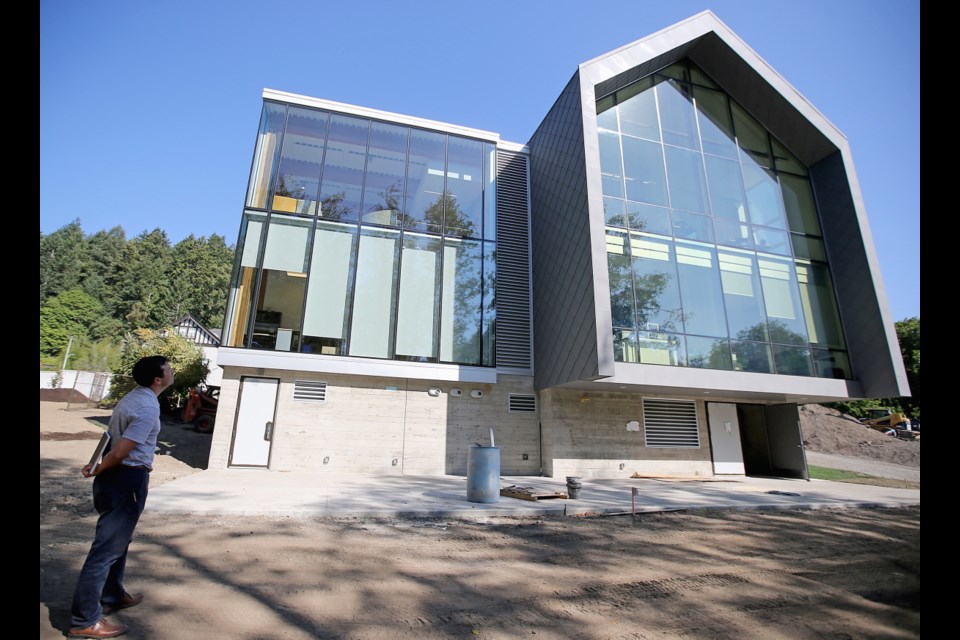In just a few weeks, students and faculty will be filling the new $24.8-million Centre for Environmental Science and International Partnership at Royal Roads University. Classes start Sept. 4. Staff and faculty are moving in now and workers are taking care of finishing touches. The building’s official opening is Sept. 7.
This is the latest project at Royal Roads, where the old garage and stables in the Mews, once used by the Dunsmuir family, has been converted for its new role. The project covers 51,666 square feet, with its new contemporary styled south-wing addition of 18,503 square feet.
The facility includes three new state-of-the-art laboratories.
Each classroom and common area has the latest audio/visual and information technology.
“That means faster and more secure internet connectivity throughout, as well as a faster and more secure IT infrastructure in each classroom to allow students and instructors to easily share large documents and video files from any of their personal devices to in-class screens and projectors, to each other and to the cloud,” Carolyn Levesque, Royal Roads senior portfolio director, who oversees all capital projects, said in a statement.
“Each classroom will also have the IT capability to host and participate in livestream online video conferencing to interact with students in other classrooms or even other institutions, locally, nationally or internationally.”
The new Terry Power Strategic and Advanced International Studies outdoor classroom is an open-concept space next to the new development. It has been built with natural materials, including all-weather seating areas for up to 50 students, Levesque said.
On-campus undergraduate programs in fields such as environmental science, tourism, business and international student programs will be using the building, which includes open spaces where students can meet.
Several environmental features were incorporated:
• It will have lower energy and emissions output than the smaller original Mews. Royal Roads anticipates saving 1,230 gigajoules in energy and expects to reduce by 44 tonnes of total carbon emissions annually. That accounts for about three per cent of the university’s total target of cutting greenhouse gases by 33 per cent, the school said in a statement.
• “Smart glass” has been used because it adjusts its tint to block glare, ultraviolet radiation and solar overheating of spaces. It will also help reduce the numbers of birds flying into windows, the statement said.
• Motion-controlled lights turn on only when people are using a space and half of the building’s electrical outlets will also turn off when a space is unoccupied, in order to cut down on wasted electricity. And CO2 sensors ensure that mechanical ventilation is activated only when spaces are occupied.
• LED lights — more efficient than fluorescents — are used indoors and outdoors.
• Outdoor lights have shields around them and direct their beams downward to avoid sending light pollution into the night sky.
• Upgraded insulation means less heating and cooling will be needed to maintain indoor temperatures.
• Nearly 60 per cent of the total floor area is made up of the existing wood-frame structure.
• Water-bottle refill stations were installed to reduce one-time plastic water bottle use.
• There are six electric vehicle chargers in nearby parking areas, along with bike racks, shelters and showers.
The $24.8-million cost includes construction, new equipment, high-tech infrastructure, furniture and native plant lanscaping. Funding came from the federal government, the province, philanthropist Sherman Jen and from the university.
The two-storey Mews is a federally recognized heritage building. It stands southwest of Hatley Castle on the Hatley Castle National Historic Site, which stands out near Esquimalt Lagoon.
Built in the early 1900s for industrialist James Dunsmuir who inherited his family’s coal fortune, Hatley Castle is a landmark in Colwood. It was constructed in a Tudor Revival design by architect Samuel Maclure. The Dunsmuir family lived on the property of more than 560 acres until 1937.
The property was purchased by the Department of National Defence in 1940 and it served as Royal Roads Military College. Royal Roads University was founded in 1995.



